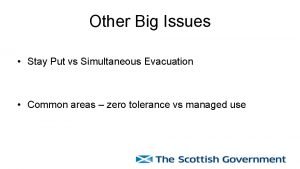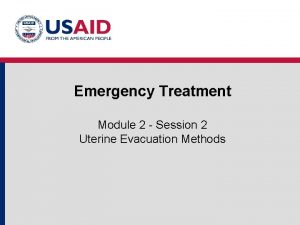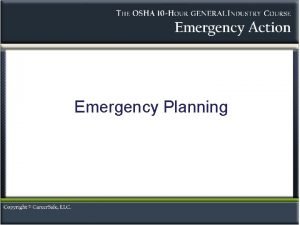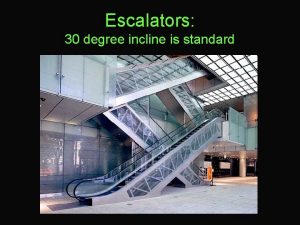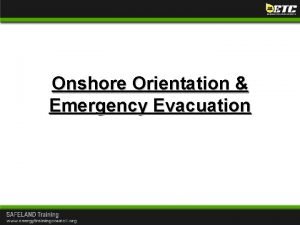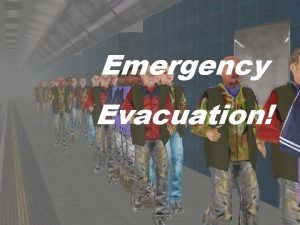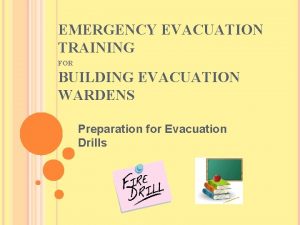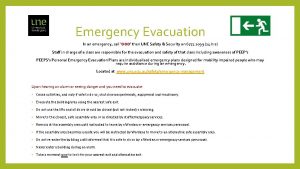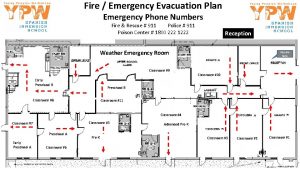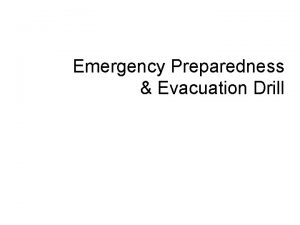Incorporating Elevators and Escalators into Emergency Evacuation Models



















- Slides: 19

Incorporating Elevators and Escalators into Emergency Evacuation Models Richard W. Bukowski, P. E. , FSFPE Senior Consultant Rolf Jensen and Associates Baltimore, MD 20708

Background • 2009 editions of IBC and NFPA 5000 permit occupant egress elevators • ASME A 17. 1 balloting Occupant Evacuation (elevator) Operation for 2013 edition, new section 2. 27. 10 • NFPA 130: 2010 permits escalators to be use for 50% of required egress capacity from a station platform – Fixed Guideway Transit

Elevators History (1) • Material lifts since 236 BC but not considered safe for people • Elisha Otis safety brake prevents car from falling if rope breaks (1852) • Passenger elevators are enabling technology for buildings taller than 6 floors

Elevators History (2) • • In 1970’s stories of fire fatalities from heat sensitive call buttons and firefighters falling down hoistways through open landing doors 2006 NFPA review of fatalities involving egress – 7 fires, 19+ fatalities in elevators • • • All but 2+ would have been prevented by FEO USA Today est. 200 in WTC not included – 3 fires where elevators used for egress, no fatalities in elevators – 3 fires where occupant survival credited to elevators including 3000 in WTC 2 – No firefighters falling down hoistways FEO recalls (Phase 1) elevators when threatened by fire – Firefighters can drive recalled cars on Phase 2

Occupant Evacuation Operation (OEO) • • Developed by ASME task groups Initially evacuate 5 floors at greatest risk Wait for IC decision for full evacuation Evacuate building from top down – Voice instructions – Information systems – Protected lobby with access to stair • Evacuate entire population of any building in under 1 hour with no additional elevators

Modeling OEO Occupant Load • Elevators usually designed for actual load for which the building is designed – Software can usually compensate for changes in occupant load, later • Design load factors (code) can be used for spec buildings • Assume load factor for cars of 85%

Modeling OEO Number of Cars • Max of 4 cars per bank (single hoistway) • Usually 2 banks per group (single controller) • Max travel distance of 150 ft to an elevator • Cars serving different groups of floors in different banks • One service car per 300, 000 to 500, 000 sqft – Smaller footprints use swing cars

Modeling OEO Handling Capacity • Common metric for design service level • Percent of building population that can be moved in 5 minutes – Up-peak or down-peak – Office buildings - 13% – Residential – 8% • IBC/NFPA require use of all publicuse cars for occupant evacuation, to maximize handling capacity and minimize egress time

Modeling OEO Passenger Capacity • Rated load (based on platform area) @ 160 lb per passenger – 3000 lb car, 19 passengers • Observed that at 2. 3 ft 2/person people will wait for next car – 0. 56 ft 2/person max in emergency • Double deck cars double capacity without increasing hoistway space • Optimized elevator designs maximize capacity while minimizing hoistway space – Terminating local hoistways to return leasable space above

Modeling OEO Startup of OEO • Unoccupied cars begin to evacuate 5 floor block • Occupied cars return to LED and discharge before joining • Shuttle mode • Sequence is fire floor, then 2 above, then 2 below, then recall to LED – One parks at lowest floor of block to retrieve stragglers

Modeling OEO Door opening and closing times • Doors open after leveling in 2 seconds • Close slower to avoid injuring people – 3 seconds for 48 in door – Code limits kinetic energy, so time depends on door weight – Some systems include a disabled button that increases dwell time and slows closing of doors

Modeling OEO Dwell Times • Time based on distance from call buttons to door established by ADA – 5 -8 sec + 1 sec person breaking light beam • Close at 85% capacity or 20 sec – Nudging – half speed close + buzzer

Modeling OEO Travel Speed • Speed selected based on travel time objectives • < 5 floors, hydraulic – 150 fpm • Traction elevators – – – 10 floor, 400 fpm 45 floor, 1000 fpm 60 floor, 1800 fpm Fastest, 3300 fpm Service cars, half speed

Modeling OEO Travel Time • Cars accelerate and decelerate slowly to avoid discomfort – 2 -8 ft/s 2 between 60% and 100% rated speed • Short trips may not reach rated speed

Modeling OEO Zoned Elevators • Industry practice to limit car stops to 15 -20 – Local and express – Low- and high-rise banks – Transfer floors (sky lobbies) • Vertical zones – Mixed use buildings – Separated lobbies – Travel through blind shaft sections

Escalators History • Nathan Ames revolving stair 1859 • First installed at Coney Island in 1896 • Not egress stairs because of variable geometry and riser height (<8. 5 in) – Stairs <7. 5 in – More comfortable but slower going up a stopped escalator • Tread depth >15. 75 in – Stairs >11 in

Escalators per NFPA 130 • Not more than 50% of required capacity – Max 2/step on 48 in width – 1. 41 p/min/in (same as stairs) • • • Escalators moving in the direction of egress travel continue moving Moving opposite the direction of egress travel are stopped Speed – 100 ft/min moving – Stopped • • • 48 ft/min down 40 ft/min up Assume 1 out of service

Modeling Egress by Stairs, Elevators and Escalators • Survey showed elevator preference on higher floors – Some will use stairs – Escalators used where present • Default to OEO – Time to initiate full evacuation user set (IC decision) – Fraction disabled and # of stragglers user set – Incorporate distributed variables (mean, SD) and batch run to obtain range of performance

Questions?
 Emergency evacuation training
Emergency evacuation training Emergency evacuation training
Emergency evacuation training Nn
Nn Incorporating the change
Incorporating the change Incorporating quotes
Incorporating quotes Incorporating pronunciation
Incorporating pronunciation Incorporating in ohio
Incorporating in ohio Unconventional cash flow
Unconventional cash flow Miller elevator uses
Miller elevator uses What is modals and semi modals
What is modals and semi modals Maxillary forceps
Maxillary forceps Single family home elevators
Single family home elevators Elevators definition
Elevators definition Vexpro elevators
Vexpro elevators Rei elevators
Rei elevators What do i remember of the evacuation analysis
What do i remember of the evacuation analysis Evacuation action
Evacuation action Evacuation coordinator
Evacuation coordinator Evacuation order no.19
Evacuation order no.19 Exemple de procedure d'evacuation incendie
Exemple de procedure d'evacuation incendie
